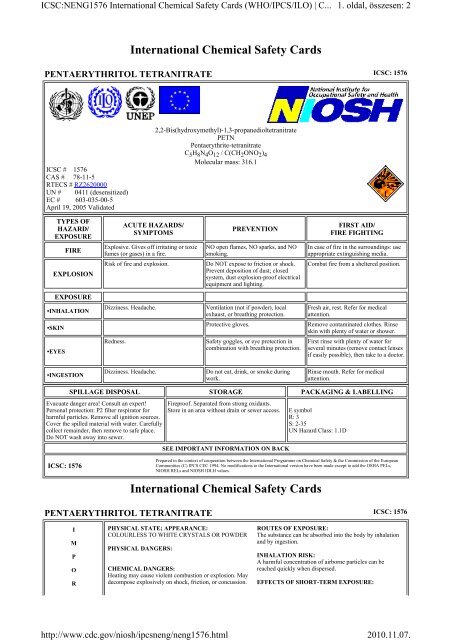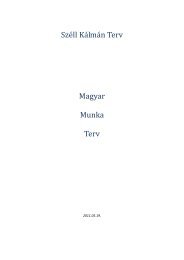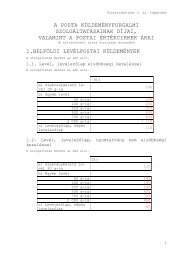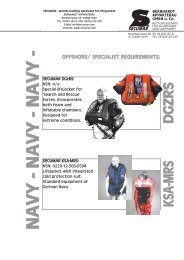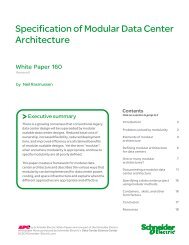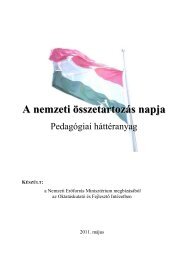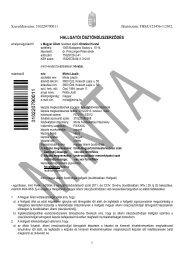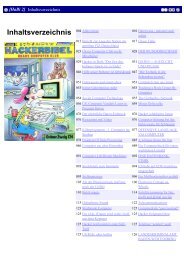International Chemical Safety Cards International Chemical Safety ...
International Chemical Safety Cards International Chemical Safety ...
International Chemical Safety Cards International Chemical Safety ...
You also want an ePaper? Increase the reach of your titles
YUMPU automatically turns print PDFs into web optimized ePapers that Google loves.
ICSC:NENG1576 <strong>International</strong> <strong>Chemical</strong> <strong>Safety</strong> <strong>Cards</strong> (WHO/IPCS/ILO) | C...<br />
http://www.cdc.gov/niosh/ipcsneng/neng1576.html<br />
1. oldal, összesen: 2<br />
2010.11.07.<br />
<strong>International</strong> <strong>Chemical</strong> <strong>Safety</strong> <strong>Cards</strong><br />
PENTAERYTHRITOL TETRANITRATE ICSC: 1576<br />
ICSC # 1576<br />
CAS # 78-11-5<br />
RTECS # RZ2620000<br />
UN # 0411 (desensitized)<br />
EC # 603-035-00-5<br />
April 19, 2005 Validated<br />
2,2-Bis(hydroxymethyl)-1,3-propanedioltetranitrate<br />
PETN<br />
Pentaerythrite-tetranitrate<br />
C 5 H 8 N 4 O 12 / C(CH 2 ONO 2 ) 4<br />
Molecular mass: 316.1<br />
TYPES OF<br />
HAZARD/<br />
EXPOSURE<br />
ACUTE HAZARDS/<br />
SYMPTOMS<br />
PREVENTION<br />
FIRST AID/<br />
FIRE FIGHTING<br />
FIRE<br />
Explosive. Gives off irritating or toxic<br />
fumes (or gases) in a fire.<br />
NO open flames, NO sparks, and NO<br />
smoking.<br />
In case of fire in the surroundings: use<br />
appropriate extinguishing media.<br />
EXPLOSION<br />
Risk of fire and explosion.<br />
Do NOT expose to friction or shock.<br />
Prevent deposition of dust; closed<br />
system, dust explosion-proof electrical<br />
equipment and lighting.<br />
Combat fire from a sheltered position.<br />
EXPOSURE<br />
•INHALATION<br />
Dizziness. Headache.<br />
Ventilation (not if powder), local<br />
exhaust, or breathing protection.<br />
Fresh air, rest. Refer for medical<br />
attention.<br />
•SKIN<br />
Protective gloves.<br />
Remove contaminated clothes. Rinse<br />
skin with plenty of water or shower.<br />
•EYES<br />
Redness.<br />
<strong>Safety</strong> goggles, or eye protection in<br />
combination with breathing protection.<br />
First rinse with plenty of water for<br />
several minutes (remove contact lenses<br />
if easily possible), then take to a doctor.<br />
•INGESTION<br />
Dizziness. Headache.<br />
Do not eat, drink, or smoke during<br />
work.<br />
Rinse mouth. Refer for medical<br />
attention.<br />
SPILLAGE DISPOSAL STORAGE PACKAGING & LABELLING<br />
Evacuate danger area! Consult an expert!<br />
Personal protection: P2 filter respirator for<br />
harmful particles. Remove all ignition sources.<br />
Cover the spilled material with water. Carefully<br />
collect remainder, then remove to safe place.<br />
Do NOT wash away into sewer.<br />
Fireproof. Separated from strong oxidants.<br />
Store in an area without drain or sewer access.<br />
SEE IMPORTANT INFORMATION ON BACK<br />
E symbol<br />
R: 3<br />
S: 2-35<br />
UN Hazard Class: 1.1D<br />
ICSC: 1576<br />
Prepared in the context of cooperation between the <strong>International</strong> Programme on <strong>Chemical</strong> <strong>Safety</strong> & the Commission of the European<br />
Communities (C) IPCS CEC 1994. No modifications to the <strong>International</strong> version have been made except to add the OSHA PELs,<br />
NIOSH RELs and NIOSH IDLH values.<br />
<strong>International</strong> <strong>Chemical</strong> <strong>Safety</strong> <strong>Cards</strong><br />
PENTAERYTHRITOL TETRANITRATE ICSC: 1576<br />
I<br />
M<br />
P<br />
O<br />
R<br />
PHYSICAL STATE; APPEARANCE:<br />
COLOURLESS TO WHITE CRYSTALS OR POWDER<br />
PHYSICAL DANGERS:<br />
CHEMICAL DANGERS:<br />
Heating may cause violent combustion or explosion. May<br />
decompose explosively on shock, friction, or concussion.<br />
ROUTES OF EXPOSURE:<br />
The substance can be absorbed into the body by inhalation<br />
and by ingestion.<br />
INHALATION RISK:<br />
A harmful concentration of airborne particles can be<br />
reached quickly when dispersed.<br />
EFFECTS OF SHORT-TERM EXPOSURE:
ICSC:NENG1576 <strong>International</strong> <strong>Chemical</strong> <strong>Safety</strong> <strong>Cards</strong> (WHO/IPCS/ILO) | C...<br />
http://www.cdc.gov/niosh/ipcsneng/neng1576.html<br />
2. oldal, összesen: 2<br />
2010.11.07.<br />
T<br />
A<br />
N<br />
T<br />
OCCUPATIONAL EXPOSURE LIMITS:<br />
TLV not established.<br />
MAK not established.<br />
The substance may cause effects on the cardiovascular<br />
system , resulting in lowering of blood pressure. Medical<br />
observation is indicated.<br />
EFFECTS OF LONG-TERM OR REPEATED<br />
EXPOSURE:<br />
D<br />
A<br />
T<br />
A<br />
PHYSICAL<br />
PROPERTIES<br />
ENVIRONMENTAL<br />
DATA<br />
Decomposes below boiling point<br />
Melting point: 138°C<br />
Density: 1.77<br />
g/cmł<br />
Solubility in water: none<br />
Vapour pressure, Pa at 25°C: negligible<br />
Octanol/water partition coefficient as log Pow: 1.6<br />
N O T E S<br />
Other UN number is 150 PETN wetted with not less than 25% of water, hazard class 1.1D. The desensitized substance contains not less than 15%<br />
phlegmatizer.<br />
Transport Emergency Card: TEC (R)-10G1.1<br />
ADDITIONAL INFORMATION<br />
ICSC: 1576<br />
(C) IPCS, CEC, 1994<br />
PENTAERYTHRITOL TETRANITRATE<br />
IMPORTANT<br />
LEGAL<br />
NOTICE:<br />
Neither NIOSH, the CEC or the IPCS nor any person acting on behalf of NIOSH, the CEC or the IPCS is responsible for the<br />
use which might be made of this information. This card contains the collective views of the IPCS Peer Review Committee<br />
and may not reflect in all cases all the detailed requirements included in national legislation on the subject. The user should<br />
verify compliance of the cards with the relevant legislation in the country of use. The only modifications made to produce the<br />
U.S. version is inclusion of the OSHA PELs, NIOSH RELs and NIOSH IDLH values.


